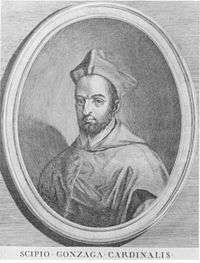Scipione Gonzaga

Scipione Gonzaga (11 November 1542 – 11 January 1593) was an Italian cardinal.
Born in Mantua, he belonged to the family of the Dukes of Sabbioneta, passed his youth under the care of Cardinal Ercole Gonzaga, and made rapid progress in Greek and Latin studies. At Bologna, and later at Padua, he studied mathematics and philosophy, and, in the latter city, founded the Accademia degli Eterei, or Academy of the Ethereals. Throughout his life he patronized literature and men of letters, among the latter being Tasso, who sought his advice concerning his Gerusalemme Liberata, and Guarino, who dedicated to him his Pastor Fido.[1] Gonzaga's home in Rome, the Palazzo Aragona Gonzaga, was a meeting place for the most eminent musicians and intellectuals of the day.
Having finished his theological studies he went to Rome, became cameriere segreto to Pope Pius IV, and was ordained priest. In the early years of the reign of Pope Gregory XIII Gonzaga had a serious lawsuit with the Duke of Mantua over some property, but they were soon reconciled. Through the Guise party, whose cause he had aided, he became Bishop of Mende in France, but Charles, Duke of Guise pleaded unsuccessfully with Gregory XIII to have him made cardinal. On 4 Oct 1585, he was consecrated bishop by Iñigo Avalos de Aragón, Cardinal-Priest of San Lorenzo in Lucina, with Enrico Caetani, Titular Patriarch of Alexandria, and Annibale de Capua, Archbishop of Naples, serving as co-consecrators.[2]
Pope Sixtus V, immediately on his elevation, appointed him Latin Patriarch of Jerusalem, and in 1587, at the request of the Duke of Mantua, raised him to the cardinalate. Sixtus also made constant use of his services in the execution of his policies, domestic and foreign.
Cardinal Gonzaga was a friend Charles Borromeo and Philip Neri, and his cousin Aloysius Gonzaga owed him eventual consent of his father to his entering the Society of Jesus. For a time Gonzaga was Governor of the March of Montferrat, in the name of the Marquess Vincenzo.
The three books of his Commentarii, written in polished Latin, are an important source of information for the history of his cardinalate; they were edited at Rome in 1791. He was buried in the church of San Sebastiano al Palatino in Rome He had 7 children between 1565 and 1579.
Episcopal succession
While bishop, he was the principal consecrator of:[2]
- Marcantonio Bizzoni, Bishop of Foligno (1586);
- Sebastian Breuning, Auxiliary Bishop of Augsburg (1587);
- Fabio Biondi, Titular Patriarch of Jerusalem (1588);
- Camilli Caetani, Titular Patriarch of Alexandria (1588);
- Gerolamo Vela, Bishop of Larino (1591);
- Ludovico Alferio, Bishop of San Marco (1591); and
the principal co-consecrator of:[2]
- Cristóbal Senmanat y Robuster, Bishop of Orihuela (1587).
He also ordained Francesco Maria Bourbon Del Monte Santa Maria (1589) to the priesthood.[2]
References
- ↑
 Herbermann, Charles, ed. (1913). "Scipione Gonzaga". Catholic Encyclopedia. New York: Robert Appleton Company.
Herbermann, Charles, ed. (1913). "Scipione Gonzaga". Catholic Encyclopedia. New York: Robert Appleton Company. - 1 2 3 4 "Scipione Cardinal Gonzaga" Catholic-Hierarchy.org. David M. Cheney. Retrieved July 23, 2016
![]() This article incorporates text from a publication now in the public domain: Herbermann, Charles, ed. (1913). "article name needed". Catholic Encyclopedia. New York: Robert Appleton.
This article incorporates text from a publication now in the public domain: Herbermann, Charles, ed. (1913). "article name needed". Catholic Encyclopedia. New York: Robert Appleton.
